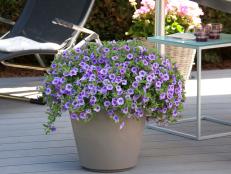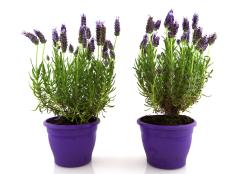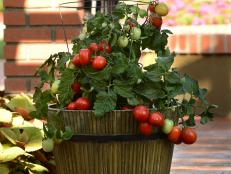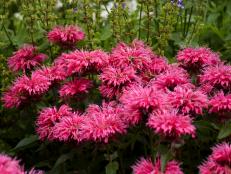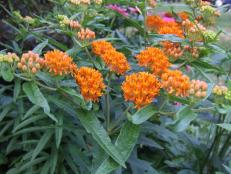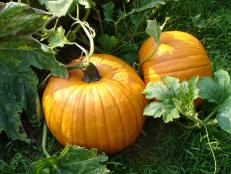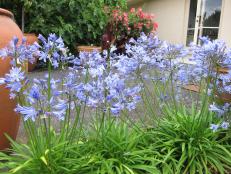Growing Asparagus Ferns
Grow airy, feathery asparagus ferns as houseplants or garden ornamentals. Indoors or out, asparagus fern care is easy.

Ball Horticultural Company
Asparagus fern care is easy. These feathery, trailing asparagus ferns contrast beautifully with dark red begonias.

If you're wondering which asparagus fern types are the best to grow, you'll find lots of choices. You can tuck different asparagus fern varieties into containers as filler plants, let them trail from hanging baskets, add them to beds and borders or simply enjoy them as houseplants.
Just don't eat them. Although these South African natives are in the asparagus family, they're not the same as Asparagus officinalis, the edible vegetable. Asparagus fern plants are mildly to moderately toxic to animals and people.

Proven Winners/Chris Brown Photography
Let a window box overflow with Proven Accents asparagus ferns, 'Rockapulco' double impatiens, 'Charmed Wine' shamrock plants and Proven Accents 'Goldilocks' creeping jenny complete the arrangement.
These warm-weather perennials, which are hardy in Zones 9 to 11, aren't true ferns because they produce seeds instead of spores. While they're named for their feathery, fern-like foliage, they can have sharp spines or thorns. Wear gloves when you handle asparagus fern plants.
Asparagus fern plants can have upright, trailing or branching stems with airy foliage and may reach up to 3 feet tall and 4 feet wide. Insignificant white or pinkish flowers may appear from spring into fall on mature plants that get enough light and later develop into berries.
How to Grow Asparagus Fern
While we say asparagus ferns have "leaves," the small, needle-like structures growing on their stems are technically cladodes. Cladodes are flattened, modified stems that work like leaves, taking in light and holding water. The plant's real leaves are hard to see but look like scales at the base of the cladodes.
Asparagus fern plants have fibrous roots that form thick mats and fleshy, white tubers. Grown outdoors, these fast-growing plants can be invasive and have escaped into parts of Texas, Florida and Hawaii. Check your local extension service to see if they're permitted in your area before you plant them. If they are, but you're concerned about how much they'll spread, grow them in pots sunk into the ground.
Good asparagus fern care starts with moist, well-draining potting soil or garden soil with organic matter mixed in. A slightly acidic pH of 6.5 to 6.8 is ideal. Use a sturdy container with drainage holes. Asparagus fern roots grow so vigorously, they can break through thin containers.
Outdoors, asparagus fern plants like part shade. Indoors, they need bright, indirect light. Growth is faster in brighter light.
Water
Asparagus fern plants need to stay moist, not soggy. Cut back on watering in the winter. The plants don't go dormant, but they need less as growth slows down. Once outdoor plants are established, they are relatively drought tolerant. Mist indoor plants often to keep the humidity high.
Fertilize
Feed asparagus plants with a slow-release, balanced fertilizer for indoor or outdoor plants, depending on where you're growing them. Follow the label directions for how much and how often to feed.
Weed
Stop fertilizing when growth slows down. Resume fertilizing in the spring. This is also a good time to repot your plants into bigger containers before new growth starts.
Scout for Health Issues
Asparagus fern types have few pests other than aphids, mealybugs, spider mites and whiteflies, which can show up when the plants are stressed. Spray with insecticidal soap or neem oil to control them. Outdoors, combat slugs with slug bait, traps or barriers.
If you see signs of root or crown rot, or spots on leaves, you may be overwatering. Treat with a fungicide labeled for the problem. If roots are rotting, cut off the dead or dying parts and repot.
Yellow foliage that drops off usually means the plants are too dry or aren't getting enough light. If needed, prune out yellow stems from the base. Brown foliage usually means too much light.
Caring for Asparagus Fern
Asparagus fern care is easy. The plants need even moisture, indirect light indoors and part shade outdoors.
Repot asparagus fern houseplants when their roots poke out through their drainage holes or to keep the plant from becoming rootbound.
Potted asparagus fern plants can go outside in warm weather. Bring them in before frost.
Propagating Asparagus Fern Types
Sow asparagus fern seeds indoors four to six weeks before your last frost or directly into the garden after the last frost. You may want to scarify the seeds first by rubbing them with sandpaper or shaking them in a bag with some sand. Next, let them soak in water for one day. Press the seeds into a seed starting mix or good garden soil, but don't cover them. Space them as directed on the seed packet. The seeds need light to germinate, which takes three to four weeks. Gently water them and don't let them dry out.
It's easier to start new asparagus ferns from cuttings in late winter or early spring. Separate their bulbous tubers into sections, each with some roots and foliage. Replant them and keep them evenly moist.
Asparagus Fern Types
The two most commonly grown asparagus fern varieties are 'Sprengeri' and 'Meyeri'.
'Sprengeri' (A. densiflorous 'Sprengeri') has inch-long, dark green needles and arching stems. 'Sprengeri Compacta' is a low-growing ground cover that reaches 1 to 2 feet tall and 4 feet wide. Dwarf asparagus fern, A. densiflorous 'Nana,' grows just 15 inches high.
A. densiflorous 'Myersii,' or foxtail fern, has narrow, upright, bushy stems of foliage. Not as invasive as other varieties, foxtail fern grows 2 feet tall and 3 to 4 feet across. You may also find it sold as A. 'Myers,' A. Meyeri' or A. Myersii.

Ball Horticultural Company
Fuzzy foxtail ferns can be used in containers as a "soft" focal point or mixed with petunias, sweet potato vines and other annuals that need the same basic growing conditions.
Still another variety, A. plumosa, also known as A. setaceus, is an aggressive climber with flattened, feathery sprays. Its stems of soft, ferny foliage are often used in floral arrangements. A. plumosa 'Nanus' is a dwarf type.

Plant Delights Nursery
A. densiflorus 'Graham's Cracker' is a deciduous asparagus fern hardy to Zone 5. While it stays evergreen in warm climates, it turns a handsome shade of gold before going dormant in other areas.
A fourth, less common variety, Ming fern (A. retrofractus), has spiky stems with clusters of pom-pom-like leaves. Winter hardy in Zones 9 to 11, it's a shrubby evergreen that grows 6 to 8 feet tall in arid regions of its native South Africa.






